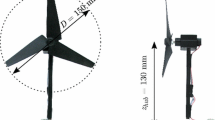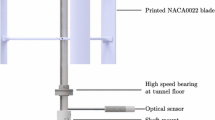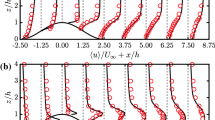Abstract
In order to properly size the mechanical ventilation system of a tunnel, it is essential to estimate the wind-driven pressure difference that might rise between its two portals. In this respect, we explore here the pressure distribution over a tunnel portal under the influence of an incident atmospheric boundary layer and, in particular, its dependency on wind direction and on tunnel geometry. Reduced scale models of generic configurations of a tunnel portal are studied in an atmospheric wind tunnel. Pressure distributions over the front section of different open cavities are measured with surface taps, which allows us to infer the influence of the tunnel aspect ratio and wind direction on a pressure coefficient \(C_{P}\), defined as a spatially and time averaged non-dimensional pressure. Experiments reveal that the magnitude of the coefficient \(C_{P}\), as a function of the wind direction, is significantly influenced by the portal height-to-width ratio and almost insensitive to its length. The experimental data set is completed by hot-wire anemometry measurements providing vertical distribution of velocity statistics. The same configurations are simulated by numerically solving the Reynolds-averaged Navier–Stokes equations, adopting the standard \(k - \varepsilon\) turbulence model. Despite some discrepancies between numerical and experimental estimates of some flow parameters (namely the turbulent kinetic energy field), the numerical estimates of the pressure coefficients \(C_{P}\) show very good agreement with experimental data. The latter is also compared to the predictions of an analytical model, based on the estimate of a spatially averaged velocity within an infinitely long street canyon. The results of the model, which takes into account varying canyon aspect ratios, are in reasonable agreement with experimental data for all cases studied. Notably, its predictions are significantly better than those provided by the simple analytical relations usually adopted as a reference in tunnel ventilation studies.












Similar content being viewed by others
References
CETU (2003) Les dossiers pilotes du CETU—Ventilation
Cóstola D, Blocken B, Hensen JLM (2009) Overview of pressure coefficient data in building energy simulation and airflow network programs. Build Environ 44(10):2027–2036
Liddament MW (1994) An overview of the AIVC numerical data base. Air Infiltration Rev. 15(4):1–5
ASHRAE (2009) ASHRAE Handbook-Fundamentals
AIPCR (1999) Fire and smoke control in road tunnels. Piarc, pp 1–6
Nyman H, Sandberg M (2011) The influence of external wind in tunnels. Int J Vent 10(1):31–48
Blendermann W (1976) On a probabilistic approach to the influence of wind on the longitudinal ventilation of road tunnels. In 2nd international symposium on the aerodynamics and ventilation of vehicle tunnels, pp B1–1
Soulhac L, Perkins RJ, Salizzoni P (2008) Flow in a street canyon for any external wind direction. Boundary-Layer Meteorol 126(3):365–388
Geograph® Britain and Ireland. http://www.geograph.org.uk/
Irwin HPAH (1981) The design of spires for wind simulation. J Wind Eng Ind Aerodyn 7:361–366
Jimenez J (2004) Turbulent flows over rough walls. Annu Rev Fluid Mech 36(1):173–196
Nironi C, Salizzoni P, Marro M, Mejean P, Grosjean N, Soulhac L (2015) Dispersion of a passive scalar fluctuating plume in a turbulent boundary layer. Part I: velocity and concentration measurements. Boundary-Layer Meteorol 156(3):415–446
Hinze JO (1975) Turbulence. McGraw-Hill, New York
Blocken B, Stathopoulos T, Carmeliet J, Hensen J (2011) Application of CFD in building performance simulation for the outdoor environment: an overview. J Build Perform Simul 4(2):157–184
Yakhot V, Orszag SA, Thangam S, Gatski TB, Speziale CG (1992) Development of turbulence models for shear flows by a double expansion technique. Phys Fluids A Fluid Dyn 4(7):1510–1520
Shih T-H, Liou WW, Shabbir A, Yang Z, Zhu J (1995) A new k–ε eddy viscosity model for high reynolds number turbulent flows. Comput Fluids 24(3):227–238
Bardina J, Huang P, Coakley T (1997) Turbulence modeling validation, testing, and development. NASA Tech. Mem., no. 110446
Murakami S, Mochida A (1988) 3-D numerical simulation of airflow around a cubic model by means of the k–ε{lunate} model. J Wind Eng Ind Aerodyn 31(2–3):283–303
Summers DM, Hanson T, Wilson CB (1986) Validation of a computer simulation of wind flow over a building model. Build Environ 21(2):97–111
Paterson DA, Apelt CJ (1986) Computation of wind flows over three-dimensional buildings. J Wind Eng Ind Aerodyn 24(3):193–213
Paterson DA, Apelt CJ (1989) Simulation of wind flow around three-dimensional buildings. Build Environ 24(1):39–50
Baetke F, Werner H, Wengle H (1990) Numerical simulation of turbulent flow over surface-mounted obstacles with sharp edges and corners. J Wind Eng Ind Aerodyn 35(C):129–147
Franke J, Hellsten A, Schlünzen H, Carissimo B (2007) “Best practice guideline for the CFD simulation of flows in the urban environment. COST Off. Brussels, ISBN 3-00-018312-4
Tominaga Y et al (2008) AIJ guidelines for practical applications of CFD to pedestrian wind environment around buildings. J Wind Eng Ind Aerodyn 96(10–11):1749–1761
Hargreaves DM, Wright NG (2007) On the use of the k–ε model in commercial CFD software to model the neutral atmospheric boundary layer. J Wind Eng Ind Aerodyn 95(5):355–369
Blocken B, Stathopoulos T, Carmeliet J (2007) CFD simulation of the atmospheric boundary layer—wall function problems. Atmos Environ 41(2):238–252
Riddle A, Carruthers D, Sharpe A, McHugh C, Stocker J (2004) Comparisons between FLUENT and ADMS for atmospheric dispersion modelling. Atmos Environ 38(7):1029–1038
Lien F-S, Yee E (2004) Numerical modelling of the turbulent flow developing within and over a 3-D building array, Part I: a high-resolution Reynolds-averaged Navier–Stokes approach. Boundary-Layer Meteorol 112(3):427–466
Dobre A et al (2005) Flow field measurements in the proximity of an urban intersection in London, UK. Atmos Environ 39(26):4647–4657
Nikuradse J (1950) Laws of flow in rough pipes. J Appl Phys 3:399
Hansen FV (1993) Surface roughness lengths. Army Res. Lab., no. AD-A274 550
Hiziroglu S, Suzuki S (2007) Evaluation of surface roughness of commercially manufactured particleboard and medium density fiberboard in Japan. J Mater Process Technol 184(1–3):436–440
Author information
Authors and Affiliations
Corresponding author
Rights and permissions
About this article
Cite this article
Kubwimana, T., Salizzoni, P., Bergamini, E. et al. Wind-induced pressure at a tunnel portal. Environ Fluid Mech 18, 769–786 (2018). https://doi.org/10.1007/s10652-018-9589-5
Received:
Accepted:
Published:
Issue Date:
DOI: https://doi.org/10.1007/s10652-018-9589-5




